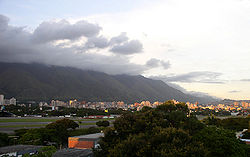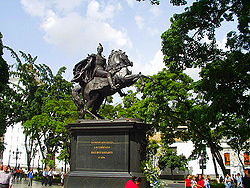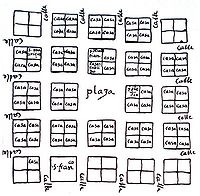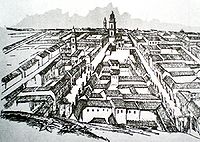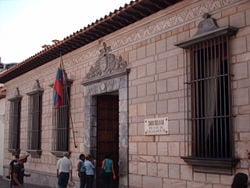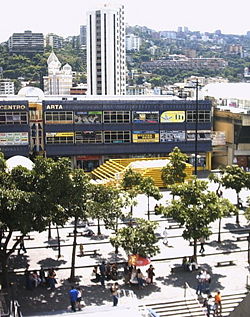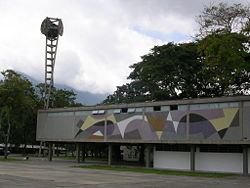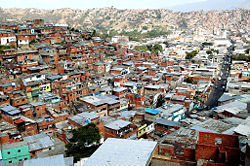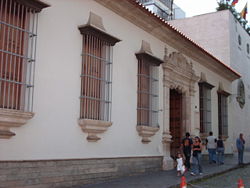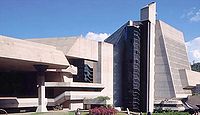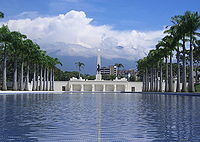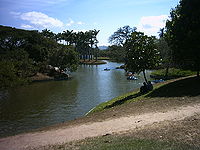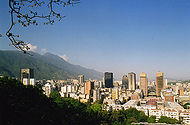Difference between revisions of "Caracas" - New World Encyclopedia
Mike Butler (talk | contribs) |
Mike Butler (talk | contribs) |
||
| Line 170: | Line 170: | ||
The actual colonial section of El Hatillo municipality represents only a small part of the total land size. Other parts of El Hatillo municipality are regular residential and commercial zones, including the neighborhoods of La Boyera, Oripoto, and La Lagunita. | The actual colonial section of El Hatillo municipality represents only a small part of the total land size. Other parts of El Hatillo municipality are regular residential and commercial zones, including the neighborhoods of La Boyera, Oripoto, and La Lagunita. | ||
| − | + | ||
| − | |||
| − | |||
===Las Mercedes=== | ===Las Mercedes=== | ||
Revision as of 23:03, 20 August 2008
| Santiago de León de Caracas | |||
|
|||
| Nickname: La Sultana del Avila (English:The Avilas' Sultan) La Sucursal del Cielo English: Heaven's branch (on earth) | |||
| Motto: Ave María Santísima, sin pecado concebida, en el primer instante de su ser natural. (English: Hail Holiest Mary, conceived without sin, in the first instant of Your Natural Being) | |||
| Coordinates: 10°30′N 66°55′W | |||
|---|---|---|---|
| Country | Venezuela | ||
| States | Capital District, Miranda | ||
| Municipalities | Libertador, Chacao, Baruta, Sucre, El Hatillo | ||
| Founded | July 25, 1567 | ||
| Government | |||
| - Mayor | Juan Barreto (MVR) | ||
| Area | |||
| - Total | 1,930 km² (745.2 sq mi) | ||
| Elevation | 900 m (2,953 ft) | ||
| Population (2005) | |||
| - Total | 3,140,076 | ||
| - Density | 1,431.5/km² (3,707.6/sq mi) | ||
| - Demonym | caraqueño(a) | ||
| Time zone | VST (UTC-4:30) | ||
| - Summer (DST) | not observed (UTC-4:30) | ||
| Postal code | 1010-A | ||
| Area code(s) | 0212 | ||
| The area and population figures are the sum of the figures of the five municipalities (listed above) that make up the city of Caracas | |||
| Website: alcaldiamayor.gob.ve (Spanish) | |||
Caracas (pronounced [kaˈɾakas]) is the capital and largest city of Venezuela. It is located in the north of the country, following the contours of a narrow mountain valley located on the Venezuelan coastal range (Cordillera de la Costa). The valley's temperatures are springlike, and the urbanized terrain of the Caracas Valley lies between 2,500 and 3,000 ft (760 and 910 m) above sea level. Caracas has the reputation as being one of the most dangerous cities in Latin America.[1][2]
Geography
Caracas is contained entirely within a valley of the Venezuelan central range, and separated from the Caribbean coast by a steep mountain range (Cerro Ávila) that rises above 7400 feet (2200 meters), and by a roughly 15km expanse of El Ávila National Park. The valley is relatively small and quite irregular. To the south lies further hills and mountains.
The elevation from sea level varies from between 2854 to 3422 feet (870 and 1043 meters), with 2953 feet (900 meters) in the historic zone. This, along with the rapid population growth, has profoundly influenced the urban development of the city. The most elevated point of the Capital District, wherein the city is located, is the Pico El Ávila, which rises to 7083 feet (2159 meters).
The city enjoys an intertropical climate. The average maximum daytime temperature of the coldest month, January, is 72°F (22°C), and the average of the warmest month, May, 75°F (24°C). Abundant fog may appear in December and January, with a sudden nightly drop in temperature to 55°F (13°C). Caracas natives call this weather the Pacheco. Precipitation varies between 35 and 51 inches (900 and 1300mm) annually, in the city proper, and up to 79 inches (2000mm) in some parts of the mountain range. Hail storms occur rarely, while electrical storms are more frequent.
The Guaire river flows across the city and empties into the Tuy river, which is also fed by the El Valle and San Pedro rivers, in addition to numerous streams which descend from El Ávila. The La Mariposa and Camatagua reservoirs provide water to the city.
Caracas covers 745 square miles (1930 square kilometers).
The city's continued growth means water supply is a critical problem. Other environmental issues concern raw sewage, that is discharged into the Guaire River, and air pollution, from industry and traffic congestion in the small valley. The Caracas valley has numerous earthquakes, most notably in 1755, 1812, and 1967.
The leafy Plaza Bolívar, near the western edge of the valley, is the focus of the old town, with a monument to El Libertador, Simon Bolívar. Numerous historic buildings in this area include Caracas Cathedral, the National Capitol, the Municipal Council building, a neatly proportioned reconstruction of the house where Simón Bolívar was born , and Miraflores Palace, which serves as the president’s official residence.
Nearby is the National Pantheon, with Bolívar’s bronze sarcophagus, and other national heros. The twin towers of the Simón Bolívar Centre are also located nearby.
The civic centre is further east, by the Parque Central, which is Caracas' art and culture hub. This is a concrete complex of five high-rise residential blocks, crowned by two 56-storey octagonal towers, one of which was damaged by fire on in 2004. The complex includes museums, cinemas, the Teresa Carreño Cultural Complex, and the Caracas Athenaeum, home to the Rajatabla theatre company.
Nearby are the Botanical Garden, several museums, the Parque Los Caobos, and the Central University of Venezuela. Further east are the Caracas Country Club, the Parque Nacional del Este, and the Francisco de Miranda Airport.
History
More than five hundred years ago, the area was populated by indigenous peoples and Caracas did not exist. Francisco Fajardo, a Spanish colonial, attempted to establish a plantation there in the year of 1562. Fajardo's stay in the valley did not last long, and he was expelled by the locals. This was the last rebellion on the part of the aborigines, for on July 25, 1567, the Spanish captain Diego de Losada laid the foundations of the city of Santiago de León de Caracas. The cultivation of cocoa stimulated the development of the city which became the capital of the province of Venezuela.
An attempt at revolution to gain independence organized by José María España and Manuel Gual was put down on July 13, 1797. But the ideas of the French Revolution and the American Revolutionary War inspired the people, and on July 5, 1811 a Declaration of Independence was signed in Caracas.
This city was the birthplace of two of Latin America's most important figures: Francisco de Miranda and "El Libertador" Simón Bolívar. An earthquake destroyed Caracas on March 26, 1812 and was portrayed by authorities as a divine punishment for rebelling against the Spanish Crown, during the Venezuelan War of Independence. The valley became a cemetery, and the war continued until June 24, 1821, when Bolívar gained a decisive victory over the Royalists at Carabobo.
As the economy of oil-rich Venezuela grew steadily (during the first part of the 20th Century), Caracas became one of Latin America's economic centers, and was also known as the preferred hub between Europe and South America. During the 1950s, Caracas began an intensive modernization program which continued throughout the 1960s and early 1970s. The Universidad Central de Venezuela, designed by modernist architect Carlos Raúl Villanueva and now a UNESCO monument, was built. Joining El Silencio, also by Villanueva, several workers' (23 de Enero, Simon Rodriguez) and new middle class residential districts (Bello Monte, Los Palos Grandes, Chuao, Cafetal, etc.) sprouted in the valley, extending its limits towards the East and South East. On October 17 2004, one of the Parque Central towers caught fire. The change in the economic structure of the country, now oil dependent, and the fast development of Caracas made it a magnet for the rural communities who migrated to the capital city in an unplanned fashion, creating the ranchos (slum) belt in the valley of Caracas.
Reference: The history and geography of a valley, by Maurice Wiesenthal, article appeared in the book Caracas, published in 1981.
Government
Venezuela is a federal republic. The president is both the chief of state and head of government, and is elected by popular vote for a six-year term. The Council of Ministers is appointed by the president. The unicameral National Assembly has 167 members elected by popular vote to serve five-year terms. Three seats are reserved for the indigenous peoples of Venezuela.
The Metropolitan District of Caracas is the official name of the district governed as Caracas. Caracas has five municipalities: Baruta, El Hatillo, Chacao, Libertador and Sucre.
The constitution of Venezuela specifies that municipal governments be divided into executive and legislative branches. The mayor manages executive government, while the municipal council manages legislative government. In March 8, 2000, the year after a new constitution was introduced in Venezuela, it was decreed that some of the powers of these municipalities would be delegated to the Alcaldía Mayor, physically located in Libertador municipality.
Economy
Venezuela remains highly dependent on oil revenues, which account for roughly 90 percent of export earnings, more than 50 percent of the federal budget revenues, and around 30 percent of GDP.
As the national capital, and as host to embassies of all countries of the world, government services are especially important in the Caracas economy, as is the entire service sector, that includes wholesale and retail trade, transportation and public utilities, education and health care. The city is the location for the head offices for Venezuela’s rporations, banks, and insurance companies, as well as the Caracas Stock Exchange.
Caracas also hosts Petróleos de Venezuela (PDVSA) which is the main company of the country, that negotiates all the international agreements for the distribution and export of petroleum.
Caracas is Venezuela's leading manufacturing centre, producing chemicals, textiles, leather, food and beverages, iron and wood, paper, and printing products, chemicals, and pharmaceuticals, as well as metalware and plastics. There are also important rubber and cement factories.
Venezuala's per capita GDP was estimated at $US12,200 in 2007.
A super highway leads from Caracas to Maiquetía, La Guaira, and various beaches and resort areas. There are two long tunnels through the mountains. Buses are the main means of mass transportation, including large, and medium-sized buses, as well as minivans. The Caracas Metro has been in operation since 1981. Train services run to and from Tuy Valley cities of Charallave and Cúa.
Simón Bolívar International Airport, located in Maiquetía, about 13 miles (21km) from the city centre, provides international and domestic flights, as do two smaller airports, La Carlota and Francisco de Miranda. The seaports La Guaira and Puerto Cabello handle imports and exports.
Demographics
The city of Caracas had an estimated population of 3,140,076 in 2005. The population of Greater Caracas' urban agglomeration (including neighboring cities out of the Capital District) is approximately 4.7 million people.[3] Caracas was ranked as the world's 119th largest urban area.
The mixture of races and cultures has been an accepted part of life in Caracas. During colonial times, Spaniards mixed with local native Indians and again with African slaves brought to work on the cocoa and coffee fields. Independence and the discovery of petroleum brought European immigrants. The 1980s and 1990s saw growing numbers of immigrants hailing from neighboring countries such as Colombia, Ecuador, Peru, Bolivia, Trinidad and Tobago, and Haiti.
Therefore, it is not difficult to find blond people with dark eyes, as well as very dark people with blondish hair and blue eyes. Nevertheless, the common demography would be "mulatos" (people of mixed black and white ancestry), "mestizos" (mixed white and native Indian), and "criollos" (an amalgamation of three races).
The city has grown haphazardly. No demographic planning has ever been carried out, thus there are entire districts and neighborhoods of Caracas lacking water and electrical systems, not to mention other services like schools, hospitals, police, fire departments. Therefore, some suburbs and districts are lawless.
The most widely-spoken and official language is Spanish, although English is used in tourist facilities. About 31 indigenous languages are spoken. European immigrant communities and their descendants commonly use their own native languages.
Nominally 96 percent of the population is Roman Catholic, two percent are Protestant, and the remainder follow other religions.
The Central University of Venezuela is a premier public University, one of 13 universities located in Caracas. Founded in 1721, it is the oldest university in Venezuela and one of the first in Latin America. Universidad Simón Bolívar is a public institution located in Caracas, Venezuela with a scientific and technological orientation.
Of interest
Caracas is Venezuela's cultural capital, boasting several restaurants, theaters, museums, and shopping centers.
- The Capitolio Federal occupies an entire city block, and, with its golden domes and neoclassical pediments, can seem even bigger. The building was commissioned by Antonio Guzmán Blanco in the 1870s, and is most famous for its Salón Elíptico, an oval hall with a mural-covered dome and walls lined with portraits of the country's great and good.
- The Parque del Este is a green paradise in the middle of the city, includes a small zoo. A replica of the Santa Maria ship, used by Christopher Colombus in his voyages to discover America was located in the park before it was destroyed by the government of Hugo Chavez.
- The main campus of the Central University of Venezuela, designed by architect Carlos Raúl Villanueva and declared World Heritage by UNESCO in 2000, is considered to be a masterwork of Modern Architecture and Art.
Museo de Arte Colonial
The gardens that surround this museum are almost as enticing as its interior. The museum is housed in a gorgeous colonial country mansion known as Quinta Anauco, which is surrounded by beautiful greenery. Inside the house you'll find meticulously restored rooms, filled with carefully selected works of art, furniture and period household and many other historical artifacts.
The "Quinta" was well outside the historic town when it was built back in 1797, but today it's an oasis in the inner suburb of San Bernardino. Head there late on a Sunday morning and you might catch a chamber music concert in rooms which were once the house stables
El Hatillo
El Hatillo is a colonial town located at the south-east suburbs of Caracas in the municipal area of the same name. This small town, which is one of Venezuela's few well-preserved typical colonial areas, gives an idea of what Caracas was like in centuries past. Just like every town in Venezuela, El Hatillo has its own Plaza Bolívar with El Libertador's statue in the middle. It also has a well preserved Roman Catholic Church, and many colonial houses. Even the municipal government, banks, and bookshops in this neighborhood keep the colonial look, with tall windows, floor-to-top wood doors, and red tile roofs.
The actual colonial section of El Hatillo municipality represents only a small part of the total land size. Other parts of El Hatillo municipality are regular residential and commercial zones, including the neighborhoods of La Boyera, Oripoto, and La Lagunita.
Las Mercedes
For those who wish to know the most commercial and cosmopolitan district of Caracas, you must visit Las Mercedes, this zone reunited some of the best restaurants of the city, that include the diverse gastronomical specialties, along with pleasant pubs, bars and pools. It is the favorite meeting place of the Caracas youth, it has some of the most exclusive stores of the city.
Altamira neighborhood
Altamira is a neighborhood located in the Chacao municipality of Caracas, it has its own Metro Station, many hotels and restaurants, and is an important business center of the city, the Francisco de Miranda avenue (a major avenue in Caracas) and the Distibuidor Altamira (a congested highway exit) are both located in Altamira.
Caracas Cathedral
The Cathedral is situated in one corner of the Plaza Bolívar, it was founded in 1594. The parents of Simón Bolívar are buried there, besides its hand carved altars, it possesses some magnificent works of art, a Resurrection by Rubens, the Presentation of the Virgin by Murillo, and the Last Supper, an unfinished work by the Venezuelan painter Arturo Michelena.
San Francisco Church
Along with the Cathedral, the church of San Francisco is one of the most important religious buildings in Caracas. It houses some XVII century masterpieces of art, carvings, sculptures and oil paintings. The Central University of Venezuela, created in the time of Philip V, was lodged in the church cloisters, today is the seat of the Language Academy, and the Academies of History, Physics, and Mathematics. This church is of much historical and sentimental value to the people of Caracas, for it was in its precincts where the people congregated in 1813, to concede the title of El Libertador (The Liberator) to Simón Bolívar.
Culture
Museums, libraries and cultural centres
Caracas, has been a city with great cultural aspirations throughout the course of its history. Institutions such as the old Atheneum bear witness to this awareness. The National library holds a great amount of volumes, and affords abundant bibliographic information for the student of the discovery and independence of Venezuela. The museum of Colonial Art has on show an interesting exhibition of Venezuelan art from the periods previous to its independence with fountains, furniture, colonial courtyards etc. In the Fine Arts Museum are kept some highly interesting archaeological finds with some good examples of precolombine pottery. Also worthy of a visit in its art gallery with its many masterpieces by international and venezulean painters. Art enthusiasts should not miss a visit to the Arturo Michelena Art Museum, situated in the former studio of this great Venezuelan artist. Since 1974, Caracas has had a Contemporary Art Museum, containing magnificent works representing the most important tendencies in contemporary art, and since 1982, counts with a Children's Museum, a privately managed museum foundation, with the propose of teaching children about science, technology, culture and arts. The Natural Science Museum, has a rich collection os archaeological pieces from the primitive native cultures, in these collections and in other no less important galleries (the Raúl Santana Creole Museum, The Transport Museum, the Coin Museum, Bolivarian Museum, Jacobo Borges Museum, Carlos Cruz-Diez Museum, Alejandro Otero Museum, Sacred Museum, etc.) the cultural aspirations of Caracas are more than evident, and its interest in the future, is never to the detriment of the enthusiasm with the relics of the past are preserved. Behind its appearance of a dynamic city, Caracas conserves the essence of its history with an aristocratic refinement.
Gastronomy
Caracas has an important gastronomical culture, due to the influence of immigrants, for that reason is frequent to find food specialties of the diverse regions of Venezuela, jointly with international ones. A great variety of French, Italian, Spanish, Hindu, Chinese, Japanese, and Mexican restaurants exists, among others. The district of La Candelaria is very well-known by its Spanish restaurants, since the array of Galician and Canary immigrants at this zone, since the middle of the XX century, contributing to the gastronomical wealth of the city. Between the main typical foods they emphasize: Pabellón Criollo, empanadas, arepas, hallaca, Black roast beef and chicken salad. Between the typical drinks we found chicha, guarapo, carato and tizana (mixed beverage with fruits).
Biggest stew
On September 15, 2007, Caracas, Venezuela chefs broke the Guinness World Records by serving 15,000 litres, largest stew (Sancocho - enough to feed 70,000 people). 13 hours cooking in 5 meter-high pot (20,000-litre) were done with 100 helpers. They used 7,000 kilos (15,340 pounds) of vegetables and 5,000 kilos meat and chicken. Guinness officials monitored the record attempt. Mexico held the record in July.[4]
Sports
Most notably football and baseball teams are located in Caracas. Several other sports also have Caracas as their home. The baseball teams Tiburones de La Guaira and Leones del Caracas have like seat the Estadio Olímpico de la UCV, of the Central University of Venezuela, with a capacity of 25 000 spectators. The Navegantes del Magallanes, another baseball team, although it was founded in Caracas, was moved to Valencia, Carabobo, but it has a great liking in the capital, in special by its historical rivalry with the local team.
The city has two football stadiums:
- Estadio Olímpico de la UCV, with capacity of 30 000 spectators (but is being extended to 40 000 for the Copa América 2007 and seat of the Caracas Fútbol Club and Deportivo Italia)
- Brígido Iriarte stadium, with a capacity of 12 000 spectators (old seat of the Caracas Fútbol Club and Deportivo Italchacao, and seat of the Estrella Roja FC). The Caracas Football Club opens its own stadium in August 2005, called Cocodrilos Sport Park.
Caracas for being the capital of Venezuela, has the seat of the National Institute of Sports and the Venezuelan Olympic Committee as well as of many clubs and national federations of a great diversity of disciplines. Bodybuilding, in particular Female Bodybuilding has become popular in Caracas as well. The most famous names being Betty Viana and Yaxeni Oriquen, who is also a Ms. Olympia champion. Both women are also natives of Caracas.
- Caracas hosted the 1983 Pan American Games
Other pix
demography
Transport
See also
- Large Cities Climate Leadership Group
ReferencesISBN links support NWE through referral fees
- ↑ Airships to tackle Caracas crime, BBC News. Retrieved December 17, 2007.
- ↑ Venezuela, Consular Information Sheet, U.S. Department of State. Retrieved December 17, 2007.
- ↑ The Principal Agglomerations of the World, City Population. Retrieved December 17, 2007.
- ↑ Venezuela serves up record stew, BBC News. Retrieved December 17, 2007.
- World Fact Book 2008 Venezuela Retrieved August 20, 2008.
External links
- (Spanish) Caracas Virtual - Informative portal of the city.
- Caracas Brief Information Travel Guide
- Backpacking in Caracas
- Caracas Lions Baseball Club
- Caracas News from World News
- Caracas Stock Exchange
- Lonely Planet - Caracas
- Maiquetia Airport (serves Caracas)
- VenezuelaTuya's Caracas Tourism Site
-
- Mapping from Multimap or GlobalGuide or Google Maps
- Satellite image from WikiMapia
- Mapping from OpenStreetMap
Credits
New World Encyclopedia writers and editors rewrote and completed the Wikipedia article in accordance with New World Encyclopedia standards. This article abides by terms of the Creative Commons CC-by-sa 3.0 License (CC-by-sa), which may be used and disseminated with proper attribution. Credit is due under the terms of this license that can reference both the New World Encyclopedia contributors and the selfless volunteer contributors of the Wikimedia Foundation. To cite this article click here for a list of acceptable citing formats.The history of earlier contributions by wikipedians is accessible to researchers here:
The history of this article since it was imported to New World Encyclopedia:
Note: Some restrictions may apply to use of individual images which are separately licensed.



